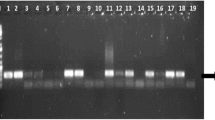Abstract
The aim of the present study was to evaluate the effect of allergic rhinitis (AR) on the nasal flora and colonization rates of resistant microorganisms in comparison to healthy individuals. This colonization may be important in terms of AR-related disorders, the resistant microorganisms’ carriage, and its complications and co-morbidities. The study was performed with two groups. The study group was composed of 54 adult patients with AR. The control group was composed of 50 healthy individuals. None of the individuals in both groups have used any antibiotics, local or systemic steroid within the last month. Composition of bacterial nasal flora and carriage rates of methicillin-resistant Staphylococcus aureus (MRSA) were evaluated with conventional methods by taking nasal smears with a swab. In the study group, methicillin-sensitive coagulase-negative staphylococci (MRCNS) were detected in 30 %; whereas diphtheroids in 25 %, methicillin-resistant coagulase-negative staphylococci in 13 %, methicillin-sensitive S. aureus in 9 %, methicillin-resistant S. aureus in 3.7 %, and extended-spectrum beta lactamases-positive gram-negative bacilli (GR-ESBL+) in 3.7 % were detected. In the control group, methicillin-sensitive coagulase-negative staphylococci were detected in 54 %; whereas diphtheroids in 21 %, methicillin-resistant coagulase-negative staphylococci in 1.5 %, methicillin-sensitive S. aureus in 16 %, methicillin-resistant S. aureus in 1.5 %, Gr-ESBL(−) in 4 %, and viridians streptococci in 3 % were detected. It is found that the MRSA and MRCNS colonization is higher in patients with AR. This colonization may be important in terms of AR-related disorders, the resistant microorganisms’ carriage, and its complications and co-morbidities in comparison to healthy subjects.

Similar content being viewed by others
References
Simons FE (1996) Learning impairment and allergic rhinitis. Allergy Asthma Proc 17:185–189
Gunhan K, Unlu H, Yuceturk AV, Songu M (2011) Intranasal steroids or radiofrequency turbinoplasty in persistent allergic rhinitis: effects on quality of life and objective parameters. Eur Arch Otorhinolaryngol 268(6):845–850
Axelsson A, Brorson JE (1973) The correlation between bacteriological findings in the nose and maxillary sinus in acute maxillary sinusitis. Laryngoscope 83:2003–2011
Sewell CM, Clarridge J, Lacke C, Weinman EJ, Young EJ (1982) Staphylococcal nasal carriage and subsequent infection in peritoneal dialysis patients. JAMA 248:1493–1495
Wertheim HF, Melles DC, Vos MC et al (2005) The role of nasal carriage in Staphylococcus aureus infections. Lancet Infect Dis 5:751–762
Kluytmans J, vanBelkum A, Verbrugh H (1997) Nasal carriage of Staphylococcus aureus: epidemiology, underlying mechanisms, and associated risks. Clin Microbiol Rev 10(3):505–520
Davis KA, Stewart JJ, Crouch HK, Florez CE, Hospenthal DR (2004) Methicillin-resistant Staphylococcus aureus (MRSA) nares colonization at hospital admission and its effect on subsequent MRSA infection. Clin Infect Dis 39(6):776–782
National Nosocomial Infections Surveillance (NNIS) (2003) System Report: data summary from January 1992 through June 2002, issued August 2003. Am J Infect Control 31:481–498
Lina G, Boutite F, Tristan A, Bes M, Etienne J, Vandenesch F (2003) Bacterial competition for human nasal cavity colonization: role of Staphylococcal agr alleles. Appl Environ Microbiol 69(1):18–23
Ucuncu H, Uslu H, Ozbek A, Aktan B, Sutbeyaz Y, Altas E (2009) Comparison of the bacterial flora of the nasal vestibule and cavity in haemodialysis patients. Acta Otorhinolaryngol Ital 29(5):251–254
Brakstad OG, Aasbakk K, Maeland JA (1992) Detection of Staphylococcus aureus by polymerase chain reaction amplification of the nuc gene. J Clin Microbiol 30(7):1654–1660
Jamaluddin TZ, Kuwahara-Arai K, Hisata K et al (2008) Extreme genetic diversity of methicillin-resistant Staphylococcus epidermidis strains disseminated among healthy Japanese children. J Clin Microbiol 46(11):3778–3783
Berglund C, Soderquist B (2008) The origin of a methicillin-resistant Staphylococcus aureus isolate at a neonatal ward in Sweden—possible horizontal transfer of a staphylococcal cassette chromosome mec between methicillin-resistant Staphylococcus haemolyticus and Staphylococcus aureus. Clin Microbiol Infect 14:1048–1056
Cole AM, Tahk S, Oren A, Yoshioka D, Kim YH, Park A, Ganz T (2001) Determinants of Staphylococcus aureus nasal carriage. Clin Diagn Lab Immunol 8(6):1064–1069
Hamilos DL (2000) Chronic sinusitis. J Allergy Clin Immunol 106:213–227
Radojicic C (2006) Sinusitis: allergies, antibiotics, aspirin, asthma. Cleve Clin J Med 73(7):671–678
Ammerlaan HS, Kluytmans JA, Wertheim HF, Nouwen JL, Bonten MJ (2009) Eradication of methicillin-resistant Staphylococcus aureus carriage: a systematic review. Clin Infect Dis 48(7):922–930
Huang SS, Platt R (2003) Risk of methicillin-resistant Staphylococcus aureus infection after previous infection or colonization. Clin Infect Dis 36:281–285
Garrouste-Orgeas M, Timsit JF, Kallel H et al (2001) Colonization with methicillin-resistant Staphylococcus aureus in ICU patients: morbidity, mortality and glycopeptide use. Infect Control Hosp Epidemiol 22:687–692
Taylor MD, Napolitano LM (2004) Methicillin-resistant Staphylococcus aureus infections in vascular surgery: increasing prevalence. Surg Infect (Larchmt) 5(2):180–187
Author information
Authors and Affiliations
Corresponding author
Rights and permissions
About this article
Cite this article
Çevik, C., Yula, E., Yengil, E. et al. Identification of nasal bacterial flora profile and carriage rates of methicillin-resistant Staphylococcus aureus in patients with allergic rhinitis. Eur Arch Otorhinolaryngol 271, 103–107 (2014). https://doi.org/10.1007/s00405-013-2492-2
Received:
Accepted:
Published:
Issue Date:
DOI: https://doi.org/10.1007/s00405-013-2492-2



